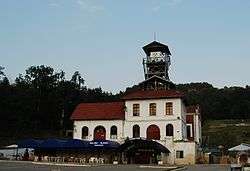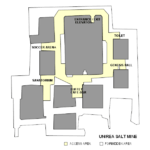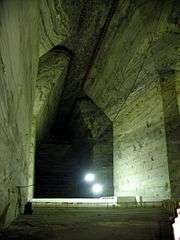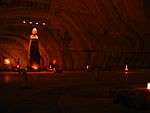Slănic mine
Slănic mine is an old salt mine, located in Slănic, Prahova County, Romania, just 100 km north of Bucharest. The salt mine is closed for extraction purposes, but is open for visitors, featuring a microclimate with natural air-conditioning and constant temperature and atmospheric pressure throughout the year. It is made up of two levels, named Unirea and Mihai. Many of the visitors come for its supposed healing effects due to the purity of the air. Throughout the mine you will find various types of equipment for recreational activity such as playground equipment and some ping-pong tables. One area is sectioned off and is used for medical patients with lung cancer to come and rest in. The main elevator shaft is unique in that it has no metallic parts due to rust. After an elevator accident in 2014, minivans are used to spiral visitors up and down.
 Slănic Salt Mine | |
| Location | |
|---|---|
 Slănic mine | |
| Location | Slănic, Prahova |
| Province | Prahova |
| Country | Romania |
| Production | |
| Products | Rock salt, Brine |
| History | |
| Opened | 1686 |
| Owner | |
| Company | Societatea Națională a Sării „Salrom S.A.” |
| Website | Slănic Salt Mine |
Unirea mine

The work for the opening of the Unirea salt mine started in 1938 and the exploitation of the salt from this mine was performed between 1943-1970.
The exploitation was done downward from the ceiling to the basis in successive slices of 2.2 meters with a horizontal cutting at the basis and vertically along the walls. The de-rocking was made through shooting. The transportation of the resulting material was effected with the tubs up the shaft using a cage to the installation of preparation and expedition.

The mine is composed of 14 chambers with trapezoidal profiles, having a 10 m opening to the ceiling and 32 m to the ground, a height of 54 m and a wall inclination angle of 60 degrees. The shore difference between the surface and the base of the mine is of 208 m and it is covered by the elevator in 90 seconds. Since 2014 the elevator is out of order. The excavated space occupies a volume of 2.9 million m³ and it is extended on a surface of 78,000 m².
After 1970, the mine becomes a touristic objective, offering exceptional natural conditions as a result of its microclimate rich in aerosols, which proved its well-known efficiency in treating the respiratory diseases. The air-conditioning of the mine is natural, with a constant temperature during the whole year of 12 °C, an atmospheric pressure of 730 mmHg and a humidity with an average of 10% lower than the surface average.

One of the chambers is a salt museum named Genesis Hall by its author Iustin Năstase and it hosts the busts in salt of Decebal and Traian. There are also other salt sculptures in the mine, such as the bust of Mihai Eminescu or a bas-relief with Mihai Viteazul, works of the local artist, Oana Brezeanu.
Some of the mine chambers were transformed in sport courts where athletes perform their trainings.
The ceiling of the mine is bordered by wooden balconies on the whole perimeter. The balconies are used for the circulation of the authorized personnel during the periodical inspection of the stability of the surfaces from the superior zone of the mine construction. The zones with uncertain stability are delimited at the base of the mine, being closed for the public access.
Mihai mine
Located vertically above the Unirea mine and separated from it by a 40m thick floor, the Mihai level was opened in 1912 and consists of 6 trapezoidal shaped rooms with a 12 m ceiling width, 37 m floor width, 66 m height and a wall inclination angle of 60 degrees.
Mining was carried out on a descending track. Until 1942, when the Unirea mine was opened, 462.332 m3 of rock salt had been excavated. This was the first salt mine in Romania provided with electric lighting.
After 1970, the Mihai mine has been the host of several national and international aeromodeling contests, occasions on which free access of tourists in the mine is also allowed.
Salt dissolution
During the fall of 1994 both levels were severely damaged by the natural phenomenon of salt dissolution due to infiltration of ground and pluvial waters, which flooded the Unirea mine. The catastrophic aggressiveness of waters flowing down the shaft gradually created huge cavities and the specialists who evaluated the full scope of the disaster decided to close down the mine. Eugen Scrob, an I.S.P.H. researcher, came up with an idea which was to keep the mine from completely collapsing. He immediately applied a new experimental method, helped by the miners of the Slanic mine. After four years of work, the stream bed was eventually regulated. Constant drillings monitored the dynamics of landslide and the piezometric level. Also, huge amounts of concrete were used to line the shaft and fill the existing cavities. All costs of these works, amounting to a total of over 20 billion Romanian lei (ROL; equivalent to 2 million RON), were exclusively borne by the Slănic salt mine. After the water was evacuated and the hearth of the flooded mine was completely drained, the site was reopened on July 31, 1998.
Gallery
 General view
General view Eminescu's statue
Eminescu's statue A mining cart
A mining cart The elevator shaft
The elevator shaft